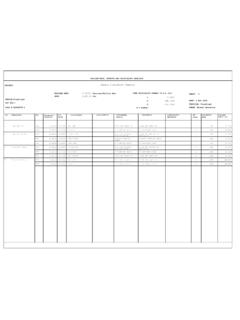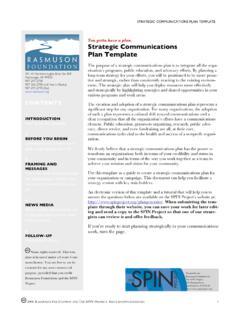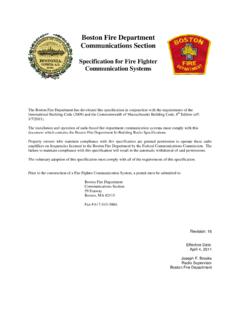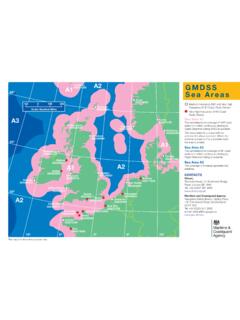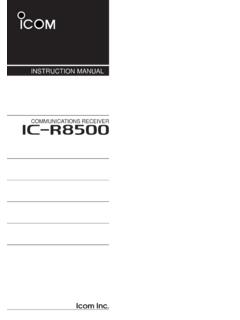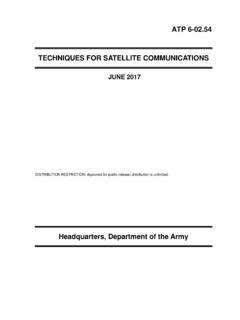Transcription of FAILURE MODES, EFFECTS AND CRITICALITY ANALYSIS …
1 TM 5-698-4 TECHNICAL MANUAL FAILURE MODES, EFFECTS AND CRITICALITY ANALYSIS (FMECA) FOR COMMAND, control , COMMUNICATIONS, computer , intelligence , surveillance , AND RECONNAISSANCE (C4 ISR) FACILITIES APPROVED FOR PUBLIC RELEASE: DISTRIBUTION UNLIMITED HEADQUARTERS, DEPARTMENT OF THE ARMY 29 SEPTEMBER 2006 TM 5-698-4 REPRODUCTION AUTHORIZATION/RESTRICTIONS This manual has been prepared by or for the Government and, except to the extent indicated below, is public property and not subject to copyright. Reprint or republication of this manual should include a credit substantially as follows: "Department of the Army, TM 5-698-4, FAILURE Modes, EFFECTS and CRITICALITY Analyses (FMECA) for Command, control , Communications, Com-puter, intelligence , surveillance , and Reconnaissance (C4 ISR) Facilities, 29 September 2006.
2 " TM 5-698-4 i Technical Manual HEADQUARTERS No. 5-698-4 DEPARTMENT OF THE ARMY Washington, DC, 29 September 2006 APPROVED FOR PUBLIC RELEASE: DISTRIBUTION IS UNLIMITED FAILURE MODES, EFFECTS AND CRITICALITY ANALYSES (FMECA) FOR COMMAND, control , COMMUNICATIONS, computer , intelligence , surveillance , AND RECONNAISSANCE (C4 ISR) FACILITIES CONTENTS Paragraph Page CHAPTER 1. INTRODUCTION TO FMECA 1-1 1-1 1-2 1-1 References.
3 1-3 1-1 Define FMECA .. 1-4 1-1 1-5 1-2 FMECA benefits .. 1-6 1-2 Team 1-7 1-3 FMECA characteristics .. 1-8 1-3 CHAPTER 2.
4 PRELIMINARY ITEMS REQUIRED Requirements .. 2-1 2-1 Goals .. 2-2 2-1 CHAPTER 3. FMEA METHODOLOGY STEPS Methodology - foundation .. 3-1 3-1 Define the system to be analyzed (functional/hardware approach) .. 3-2 3-2 Ground rules and assumptions .. 3-3 3-4 Block diagram .. 3-4 3-5 FAILURE mode identification .. 3-5 3-8 FAILURE EFFECTS 3-6 3-9 FAILURE detection methods.
5 3-7 3-12 Compensating provisions .. 3-8 3-14 Severity ranking .. 3-9 3-14 Results of the 3-10 3-16 CHAPTER 4. FMECA METHODOLOGY Methodology moving into CRITICALITY 4-1 4-1 CRITICALITY ANALYSIS .. 4-2 4-2 Transfer select data from FMEA sheet .. 4-3 4-5 Quantitative CRITICALITY 4-4 4-6 EFFECTS of redundancy 4-5 4-10 TM 5-698-4 ii Paragraph Page CONTENTS Qualitative CRITICALITY 4-6 4-12 EFFECTS of redundancy 4-7 4-19 CHAPTER 5.
6 CRITICALITY RANKING QUANTITATIVE AND QUALITATIVE CRITICALITY ranking .. 5-1 5-1 CRITICALITY matrix .. 5-2 5-1 CHAPTER 6. RESULTS OF FMECA 6-1 6-1 Recommendations from the CRITICALITY matrix example .. 6-2 6-1 CHAPTER 7. CONCLUSIONS Incentives .. 7-1 7-1 7-2 7-1 APPENDIX A REFERENCES.
7 A-1 APPENDIX B FAILURE MODE DISTRIBUTION B-1 GLOSSARY .. G-1 TM 5-698-4 iii CONTENTS LIST OF TABLES Number Title Page 3-1 Severity ranking 3-15 4-1 FAILURE mode ratio ( ) .. 4-7 4-2 Occurrence Rankings .. 4-17 4-3 Severity Rankings .. 4-18 4-4 Detection Rankings .. 4-19 LIST OF FIGURES Number Title Page 1-1 Facility development process.
8 1-3 3-1 Typical FMECA 3-1 3-2 Functional 3-2 3-3 Hardware method .. 3-3 3-4 Functional block diagram of system .. 3-6 3-5 Functional block diagram of the 3-6 3-6 Reliability block diagram .. 3-7 3-7 Example of DA Form 7610, FMEA worksheet flow (one column at a time) .. 3-10 3-8 Example of DA Form 7610, Functional FMEA system level .. 3-11 3-9 Example of DA Form 7610, FMEA progression .. 3-13 3-10 Example of DA Form 7610, Completed FMEA (functional) for industrial water supply 3-17 3-11 Completed FMEA (hardware) for HVAC 3-18 4-1 FMECA 4-1 4-2 Example of DA Form 7611, FMECA worksheet quantitative (with data).
9 4-3 4-3 Example of DA Form 7612, FMECA worksheet qualitative (no data).. 4-4 4-4 Data triangle .. 4-5 4-5 Example of DA Form 7611, Quantitative FMECA with redundant components 4-14 4-6 Single point system vs. redundant 4-20 4-7 Example of DA Form 7612, FMECA worksheet using qualitative 4-23 5-1 Example of DA Form 7613, FAILURE mode CRITICALITY ranking .. 5-3 5-2 Example of DA Form 7614, Item CRITICALITY ranking .. 5-6 5-3 CRITICALITY matrix .. 5-9 TM 5-698-4 1-1 CHAPTER 1 INTRODUCTION TO FMECA 1-1. Purpose The purpose of this manual is to guide facility managers through the FAILURE Mode, EFFECTS and CRITICALITY ANALYSIS (FMECA) process, directing them how to apply this type of ANALYSIS to a command, control , communications, computer , intelligence , surveillance , and reconnaissance (C4 ISR) facility.
10 These facili-ties incorporate several redundant systems used to achieve extremely high availability that require spe-cialized tools, which are described in this manual, to conduct an accurate ANALYSIS . 1-2. Scope The information in this manual will provide the facility manager the necessary tools needed to conduct a realistic approach to establish a relative ranking of equipments' EFFECTS on the overall system. The meth-ods used in this manual have been developed using existing concepts from various areas. These methods include an easy to use evaluation method to address redundancy's affect on FAILURE rates and probability of occurrence. Because a C4 ISR facility utilizes numerous redundant systems this method is very useful for conducting a FMECA of a C4 ISR facility.

